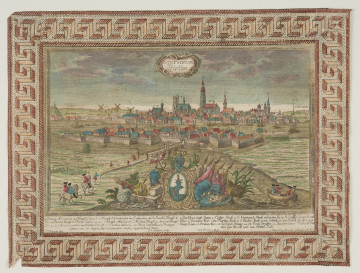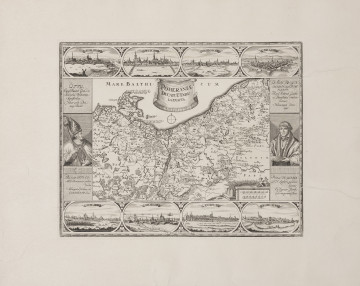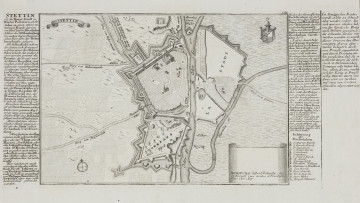
View of Szczecin in bordure
1735
National Museum in Szczecin
Part of the collection: Iconography of Szczecin in the 17th-19th centuries
After the heirless death of the last ruler of the Griffin dynasty, Prince Bogusław XIV (1580-1637) in 1637, Szczecin became the scene of conflict between Sweden and Brandenburg. Under the Duke's will, Brandenburg was excluded from the right of succession to the Pomeranian throne, and Pomerania fell to Sweden. The Griffin's death took place during the Thirty Years' War (1618-1648). At the end of the war, the Peace of Westphalia ordered the division of Pomerania between Sweden and Brandenburg. The Brandenburgers did not accept defeat this time either. In 1659 and 1676, they made unsuccessful attacks on Szczecin, but the subsequent siege in 1677 was longer and more intense than the previous one. The Elector of Brandenburg, Friedrich Wilhelm (1620-1688), decided to capture the city at any cost, harassing it with bombardments and blockades. That way, he took control of the city for two years. The then strategists considered the siege of 1677 spectacular, and the Great Elector, who regarded himself as the heir to the Griffin dynasty, considered the capture of Szczecin to be his military success and wished the achievement to be publicised through iconography. It included a plan of Szczecin made between 1677 and 1682 by Matthäus Merian the Younger (1621-1687). A native of Basel, the painter and engraver studied in the workshop of his father, Matthäus Merian, the Elder, with the German painter Joachim von Sandrart, in Paris, and the London workshop of the famous Antoon van Dyck. He was active in Frankfurt, Nuremberg and Italy. He was an agent for many princes, and from 1648, he served with the Swedish Field Marshal of the Thirty Years' War, Karl Gustav Wrangel. He also ran a publishing house, Theatrum Europaeum, after his father, in which he included a copperplate drawing of the siege of Stettin in 1682. The work was a typical military plan, showing the city in the context of its defensive capabilities. At the bottom of the right-hand corner, the artist placed a legend to individual elements on the plan in the form of an expanded scroll.
Małgorzata Peszko
Author / creator
Dimensions
cały obiekt: height: 33,5 cm, width: 38,8 cm
Object type
graphic
Creation time / dating
Creation / finding place
Identification number
Location / status

1735
National Museum in Szczecin

1720 — 1736
National Museum in Szczecin

1720 — 1740
National Museum in Szczecin
DISCOVER this TOPIC
National Museum in Lublin
DISCOVER this PATH
Educational path